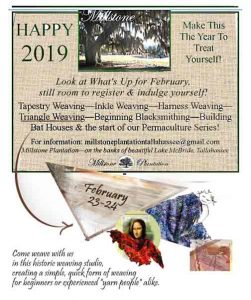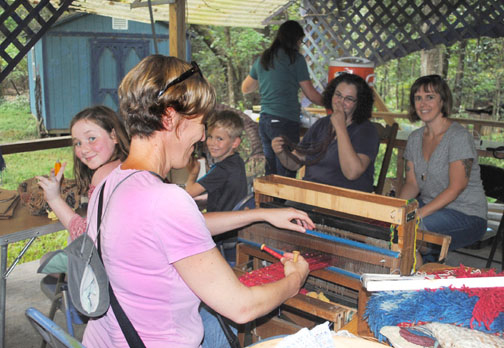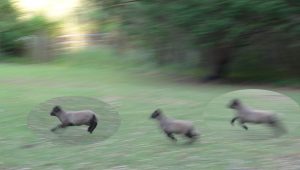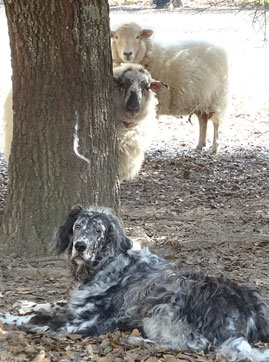
Triangle weaving is fun! Period. It offers

Triangle weaving is fun! Period. It offers

Heads Up

Preparing for a show seems to take more time than actually being there. Most of what I carry with me are props. My fiber inventory can fit into two armsized bundles, but the rest is everything needed to hold them up. When I started, waaay back in the late ’70s, my first show was in St. Augustine. This was during the “craft explosion” when artists began exhibiting in the streets, not having to wait to get curated into a gallery. It was a colorful, lively, free-for-all and the movement spread across the country. At that first show, I had no booth. I spread out a tarp and laid everything on the ground. One of the judges came by and said, “well, you have some nice work, but you gotta get a booth.”

The recent storm gave an opportunity to accustom the sheep to staying in a more secure, but unfamiliar, shelter: under the house. Remembering their #1 rule: "Eat! ALOT!" (YarnTalk, chapter 3), I filled the white bucket with grain and they followed me single file to the house. Raising the lattice, we ducked under the porch floor and I set down a large trashcan lid as a tray and dumped in the grain. They gathered 'round, easily fitting under the 4-foot-high porch floor. Sheep like low roofs. I guess that's why sheep "folds" or "cotes" are built small. They feel more secure when all bunched together. But my efforts were in vain. They ate their fill and pushed their way past the lattice and out again to graze. They don't feel the rain unless it's hard on their faces. Wool insulates them against everything: rain, wind, heat,cold. Not like fur. During the storm, the dogs were also in and out, tracking water all over the floor. Their fur was always dripping. They were more curious about the storm and just wanted to make their rounds and check again. And again. The house is built for storms. When designing it, I was fascinated with old-style plans that accomodated the South's heat and humidity. Plans like breezeways, low eaves and wide overhangs, airy cupolas, and a whole-house fan. Windows,doors, and dogdoors are open almost year-round, allowing breezes (ok, winds) to blow through during the hot months. The dogs take advantage of this. It occurred to me I was mirroring my hurricane chapter in the book (YarnTalk, chapter 8). In the story, however, the sheep stayed put, even exploring, knocking about, or dragging around everything under the house: fallen insulation, tangled wiring, plumbing, stacks of pottery and garden tools. When the power cut out and the light dimmed, I switched my attention to crafts that didn't require electricity. I could hear them below the floor and they could hear me above, pounding away on the loom. Since storm gusts were not so severe, it was actually relaxing. Our mutual sounds kept us in touch with each other while outside, beyond the porch walls, the trees danced with the wind. YarnTalk is a work in progress, following the adventures of Ivy, the lamb, as she tries to learn about making a shawl. Occasional updates and excerpts are posted here.

When kids come to visit we can do a variety of things. Small weavings on cardboard? Large weavings on wooden frames? Maybe some paper-making, or vegie-dyeing on the fire. The sheep always demand their fair share of the day – another opportunity to eat! Mimosa or grain, they’ll take it all. Kids get to personally interact with them, something they might never have done. Soft wool feels good, soft mouths tickle their hands.

pullling mimosa for the sheep
Last Sunday, visitors arrived ready to play. We visited the pasture, then settled on the deck to see the weaving/spinning demos. Afterwards, everyone grabbed for their yarns and cardboard looms and jumped into the world of fiberarts. They were working on scout badges and so got to explore various fibers, textures, colors, and whatever they intended their final project to be. These projects are meant to be finished at home, so I hope that I will get to see them later. Meanwhile, check out the photos on FB.

For more info, contact me or see alicecappa.com –
“Dyed ‘N Wool” fiber activities for kids.
Rule #1: Eat Food. Alot! ~ Rule#2: Stick With The Flock! ~ Rule#3: Be Aware! ~ Rule#4: Not To Close! ~ Rule #5: Play Games!
At about age 5-6 days to 2 weeks new

lambs suddenly get the memo that they can leave their moms and do something more athletic than reaching for the next meal. They see other lambs just like themselves and they start to play. This is when “gamboling” gets so funny. As though on a pogo stick, they bounce and twirl and hop across the pasture. From here through the next several weeks they spend much of their time in the air.
Once I filmed a lamb spinning in a twirl. He stood in one place, as though not knowing what to do, then leaped straight up, whirled, bounced down and up again, and repeated the move

3 times. Then he took off running, snapping kinetic energy between himself and the next lamb to keep them all bouncing. When they get older the energy passes, but even on a crisp autumn day, usually at sunset after a long day of napping and chewing cud, I’ve seen the whole flock gamboling, skipping, running around the pasture in a game of tag. Even a 150 lb. ram, once relieved of his fleece at shearing time, becomes like a kid again and bounces back and forth across the pasture in a spurt of freedom.
Another game sheep like is King-Of-The-Mountain. Usually mom is the mountain. This could be inspired by a large woodpile, a mound of high ground, or any older sheep who’ll lie still for the game. And this is why commercial growers may use lightweight jackets ( fleece protectors) on their sheep. The lambs don’t
Rule #1: Eat Food. Alot! ~ Rule#2: Stick With The Flock! ~ Rule#3: Be Aware! ~ Rule#4: Not To Close! ~ Rule #5: Play Games!



Rule #2: STICK WITH THE FLOCK! Always!
Sheep are flock animals and have close family ties. Mothers and kids will hangout together, in all activities, in all venues, forever. They may slightly separate themselves from other family groups, but always within eyesight. When one responds to something, they all do. Their telepathy is strong, except when one zones out in her own little dream world and takes a few minutes to catch up. Ivy is one of those. When she grazes, I think the action of stepping and chewing, stepping and chewing must be very meditative. Being independent and curious, she will also venture off for a solitary nap, or explorations deeper under the trees. I sometimes call and call when ready to move them to an alternate spot and though the others come running, I often need to search for Ivy, who’s off pawing some new plant she found, distant from the flock, or asleep in a hole, behind the fallen tree, down in the woods, so completely out of sight I might step on her before she wakes.
One exception to the flock rule may be when young lambs are sleeping. They play hard, then drop and take a nap. The ewes keep grazing and gradually widen the spaces between them. Often, one ewe plays babysitter, while the other moms drift away. Then they meet up and switch roles. Other times, they all drift away and forget where they left the lambs. That’s cause for all-out shouting until the lambs wake up and they all find each other again.
But this brings up pecking orders. Even though they stick together and mimic each other, there is a separation of power and who gets to go first. Did you know the ram is not the leader of the flock? His job is to protect and bully and make little lambs. If danger threatens, he’ll face it and even though he’s no match for most predators, he’ll make a big show of it. Mostly with other rams. I personally think they’re not all that brave. They wait ’til you turn your back, then they butt you.
It’s the Head Ewe who leads the flock, decides where the best pasture is, who eats first, and who steps ahead of the line of ewes and lambs all in single file to their next location. With my small family of sheep, it’s Swee’Pea who answers my call first, leads the stampede to breakfast, and yells when the flock needs something. Swee’Pea is the daughter of the original SnoBelle from the story, and also Ivy’s mom. Though always part of the flock, their independence runs deep.

In YarnTalk, my story of the lambs and the fiber processes, Maa Dixie Belle gives 5 rules for the flock. No. 1 is “Eat Food! Alot!”
The others I’ve deduced from watching them, usually based on how they sense their world around them. The other rules are:
2. Stick with the flock!
3. Be aware!
4. Not too close!
5. Play Games!
More on those later.
#1 – EAT! seems to be written in capital letters, just for them. They’re always hungry. Though many sheep will live off forage entirely,